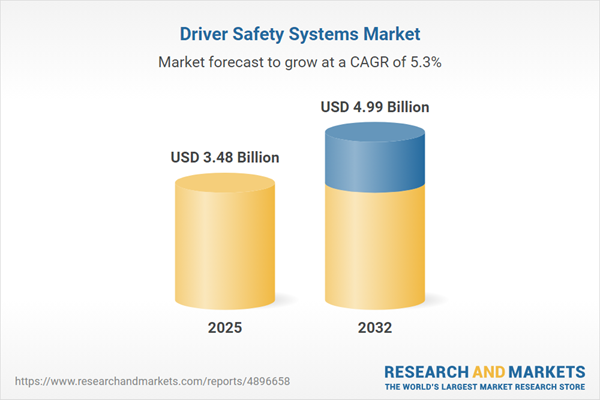Speak directly to the analyst to clarify any post sales queries you may have.
The driver safety systems market is undergoing notable transformation, shaped by rapid advancements in technology and evolving regulatory frameworks. Senior decision-makers are increasingly adopting emerging safety features to support operational excellence, manage risk, and maintain organizational resilience in a competitive sector.
Market Snapshot: Driver Safety Systems Market Growth
The driver safety systems market grew to USD 3.48 billion in 2025 from USD 3.31 billion in 2024 and is expected to reach USD 4.99 billion by 2032, driven by a compounded annual growth rate of 5.27%. This growth is propelled by higher demand for intelligent in-vehicle safety, broader implementation across various vehicle types, and the influence of international safety regulations. Regulatory and consumer priorities are prompting organizations to integrate advanced safety systems into procurement and vehicle design strategies, ensuring safety is central to automotive innovation.
Scope & Segmentation
- System Types: Adaptive cruise control, automatic emergency braking, blind spot detection, driver monitoring systems, electronic stability control, and lane departure warning are enhancing both driver awareness and proactive risk response measures, addressing the needs of organizations with diverse operating environments.
- Component Types: Processor technologies such as digital signal processors, field-programmable gate arrays, and microprocessors, along with a range of sensors including cameras, LiDAR, radar across all ranges, and ultrasonic devices, supported by software algorithms and firmware, form the foundation of modern safety systems. These integrated architectures empower OEMs to achieve greater responsiveness and data-driven reliability.
- Vehicle Types: Differentiation between commercial vehicles (covering both heavy and light segments) and passenger cars influences architecture and regulatory compliance, ensuring solutions are optimized for unique legal standards and operational demands present in each vehicle category.
- Sales Channels: Options span aftermarket channels, which include direct-to-consumer and distributor models, as well as original equipment manufacturer (OEM) integration. The choice of channel impacts system compatibility, updates, and the effectiveness of deployment across global markets.
- Regions Covered: Comprehensive geographic analysis includes the Americas—encompassing the United States, Canada, Mexico, Brazil, Argentina, Chile, Colombia, and Peru; Europe, Middle East & Africa—covering leading markets such as the United Kingdom, Germany, and France, alongside regions in the Middle East and Africa; and Asia-Pacific—comprising China, India, Japan, Australia, South Korea, Indonesia, Thailand, Malaysia, Singapore, and Taiwan. This diverse coverage enables systematic global deployment and region-specific customization to address local requirements.
- Key Companies: Notable players such as Mobileye Global Inc., Robert Bosch GmbH, Continental AG, Denso Corporation, Aptiv PLC, ZF Friedrichshafen AG, Magna International Inc., Valeo SA, Autoliv Inc., and Hella GmbH & Co. KGaA are leading technological progress and partnerships that shape the value chain, supply stability, and deployment speed.
Key Takeaways for Senior Decision-Makers
- Adoption of sensor fusion, machine learning, and real-time analytics is changing automotive strategies and product roadmaps across the sector.
- Continual regulatory changes require sustained investment in new features and faster integration of compliance measures, affecting development cycles for both established and emerging players.
- Heightened end-user expectations have made intelligent safety a core automotive feature, impacting supplier selection and influencing the rollout of connected system updates.
- Distinct usage patterns between commercial fleets and passenger vehicles drive differentiated solutions, affecting localization, deployment timing, and system integration approaches for each segment.
- Collaboration among major suppliers is enabling greater interoperability between hardware and software components, supporting seamless system performance and reducing integration risks for end-users.
Tariff Impact on Cost Structure and Supply Chain Strategy
Recent tariffs in the United States have increased costs for critical driver safety system components, including high-resolution cameras and semiconductors. As procurement expenses rise, organizations are adjusting by diversifying their sourcing networks and evaluating alternative production sites. Partnerships with regional suppliers are becoming more strategic, aiming to limit tariff impacts and safeguard continuous product availability, especially for organizations concerned with maintaining consistent distribution and service levels.
Methodology & Data Sources
This market intelligence is supported by comprehensive secondary research, accessing technical papers, regulatory updates, and corporate filings. Primary research included direct interviews with industry leaders and regulatory specialists, while cross-verification was accomplished through production record analysis and in-service performance reviews.
Why This Report Matters
- Provides actionable intelligence for adapting strategy in an environment shaped by evolving safety standards and rapid technology adoption.
- Empowers procurement, R&D, and regional operations teams to optimize sourcing and form scalable rollout frameworks that respond efficiently to shifting partner and market demands.
- Supports benchmarking of current operational positioning and uncovers growth opportunities across a broad array of established and emerging regional markets.
Conclusion
Driver safety systems are central to modern automotive strategy, setting new benchmarks for risk mitigation, technological integration, and operational efficiency. This report offers targeted analysis to guide decision-makers in maintaining competitive advantage as market dynamics continue to evolve.
Additional Product Information:
- Purchase of this report includes 1 year online access with quarterly updates.
- This report can be updated on request. Please contact our Customer Experience team using the Ask a Question widget on our website.
Table of Contents
3. Executive Summary
4. Market Overview
7. Cumulative Impact of Artificial Intelligence 2025
List of Figures
Samples

LOADING...
Companies Mentioned
The key companies profiled in this Driver Safety Systems market report include:- Mobileye Global Inc.
- Robert Bosch GmbH
- Continental AG
- Denso Corporation
- Aptiv PLC
- ZF Friedrichshafen AG
- Magna International Inc.
- Valeo SA
- Autoliv Inc.
- Hella GmbH & Co. KGaA
Table Information
| Report Attribute | Details |
|---|---|
| No. of Pages | 197 |
| Published | October 2025 |
| Forecast Period | 2025 - 2032 |
| Estimated Market Value ( USD | $ 3.48 Billion |
| Forecasted Market Value ( USD | $ 4.99 Billion |
| Compound Annual Growth Rate | 5.2% |
| Regions Covered | Global |
| No. of Companies Mentioned | 11 |









